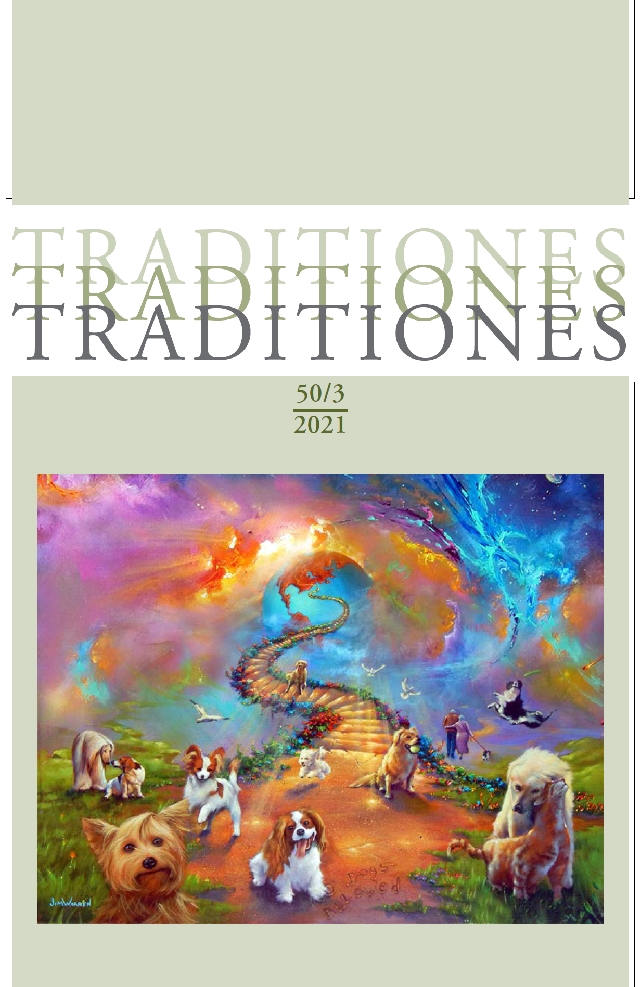Sworn Virgins of the Balkan Highlands
DOI:
https://doi.org/10.3986/Traditio2021500306Keywords:
honour, social anomaly, sworn virgins, traditional ritual, Western BalkansAbstract
Once widely spread in the Dinaric Mountains part of the Balkan Peninsula swearing to virginity was a social and cultural custom recorded among all groups inhabiting the area. In the absence of a capable adult man in the household, a daughter would take over his social role by ‘becoming’ a man. The standard explanation is that the function of this practice is enabling the continuation of the household’s economic, social, and religious activities. We argue that this explanation fails. A better explanation is that, because the lack of a particular kind of a man (competent and honourable) was perceived as a shame in these societies, the primary reason for swearing to virginity was saving family honour.
Downloads
References
Barjaktarović, Mirko. 1948. Prilog proučavanju tobelija (zavetovanih devojaka). Zbornik Filozofskog fakulteta I: 343–352.
Barjaktarović, Mirko. 1966. Problem tobelija (virdžina) na Balkanskom poluostrvu. Glasnik Etnografskog muzeja u Beogradu 28–29: 273–286.
Bošković, Aleksandar. 1996. Constructing Gender in Contemporary Anthropology. PhD Thesis. University of St Andrews.
Dekker, Rudo M., and Lotte C. van de Pol. 1989. The Tradition of Female Transvestism in Early Modern Europe. Houndmills: Macmillan Press Ltd. DOI: https://doi.org/10.1007/978-1-349-19752-1.
Denich, Bette S. 1974. Sex and Power in the Balkans. In Woman, Culture and Society, eds. Michelle Z. Rosaldo and Louise Lamphere, 243–262. Stanford: Stanford University Press.
Dickemann, Mildred. 1997. The Balkan Sworn-Virgin: A Cross-Gendered Female Role. In Islamic Homosexualities: Culture, History and Literature, eds. Stephen O. Murray and Will Roscoe, 197–203. New York: New York University Press.
Djajic Horváth, Aleksandra. 2003. A Tangle of Multiple Transgressions: The Western Gaze and the Tobelija (Balkan Sworn-Virgin-Cross-Dressers) in the 19th and 20th Centuries. Anthropology Matters Journal 2. https://www.anthropologymatters.com/index.php/anth_matters/article/view/119/234.
Douglas, Mary. 1984 (1966). Purity and Danger: An Analysis of the Concepts of Pollution and Taboo. London, New York: Routledge.
Durham, Mary E. 1910. High Albania and its Customs in 1908. Journal of the Royal Anthropological Institute 40: 453–72.
Đorđević, Tihomir. 1984 (1930). Naš narodni život 6, 276–278. Beograd: Prosveta. [Originally published in Sveslovenski zbornik (Zagreb).]
Gavrilović, Ljiljana. 1983. Tobelije: Zavet kao osnov sticanja pravne i poslovne sposobnosti. Glasnik Etnografskog muzeja 47: 67–80.
Grémaux, René. 1989. Mannish Women of the Balkan Mountains: Preliminary Notes on the ‘Sworn Virgins’ in Male Disguise, with Special Reference to Their Sexuality and Gender-Identity. In From Sappho to De Sade: Moments in the History of Sexuality, ed. Jan N. Bremmer, 143–172. London: Routledge.
Grémaux, René. 1992. Fransciscan Friars and the Sworn Virgins of the North Albanian Tribes. Religion State & Society 20 (3-4): 361–374. DOI: https://doi.org/10.1080/09637499208431565.
Grémaux, René. 1994. Woman Becomes Man in the Balkans. In Third Sex, Third Gender — Beyond Sexual Dimorphism in Culture and History, ed. Gilbert Herdt, 241–281. New York: Zone Books.
Gušić, Marijana. 1958. Ostajnica-tombelija-virdžina kao društvena pojava. In Treći kongres folklorista Jugoslavije držan od 1-9.IX.1956.g. u Crnoj Gori, ed. M. S. Lalević, 55–64. Cetinje: Savez folklorista FNRJ.
Gušić, Marijana. 1976. Pravni položaj ostajnice-virđineše u stočarskom društvu regije Dinarida.’ In Odredbe pozitivnog zakonodavstva i običajnog prava o sezonskim kretanjima stočara u Jugoistočnoj Evropi kroz vekove: Zbornik radova sa međunarodnog naučnog skupa održanog 6. i 7. novembra 1975. u Beogradu, ed. Vasa Čubrilović, 269–295. Beogad: Srpska akademija nauka i umetnosti.
Heneberg-Gušić, Marijana. 1930. Etnografski prikaz Pive i Drobnjaka. Etnološka biblioteka 10: 3–17.
Jovanović, Miroslav, and Slobodan Naumović, eds. 2004. Gender Relations in South Eastern Europe: Historical Perspectives on Womanhood and Manhood in 19th and 20th Century. Münster: Lit Verlag.
Kaser, Karl. 1994. Die Mannfrau in den patriarchalen Geselschaften des Balkans und der Mythos vom Matriarchat. L’Homme 5 (1): 59–77.
Mascia-Lees, Frances E., and Nancy Johnson Black. 2017. Gender and Anthropology. 2nd Ed. Long Grove: Waveland Press.
Medaković, Milorad. 2001 (1860). Život i običaji Crnogoraca. Beograd: Nikola Pašić.
Moore, Henrietta. L. 1988. Feminism and Anthropology. Minneapolis: University of Minnesota Press.
Simić, Andrei. 1967. The Blood Feud in Montenegro. Essays in Balkan Ethnology (Berkeley) 1: 83–94.
Šarčević, Predrag. 1999. Tobelija: Female-to-Male Cross-Gender Role in the 19th and 20th Century Balkans. In the Archives and the Field: Dialogue on Historical Anthropology of the Balkans, eds. Miroslav Jovanović, Karl Kaser and Slobodan Naumović, 135–146. Belgrade, Graz: Udruženje za društvenu istoriju, Institut für Geschichte der Universität Graz, Abteilung Südosteuropäische Geschichte.
Šarčević, Predrag. 2004. Sex and Gender Identity of ‘Sworn Virgins’ in the Balkans. In Gender Relations in South Eastern Europe: Historical Perspectives on Womanhood and Manhood in 19th and 20th Century, eds. Miroslav Jovanović and Slobodan Naumović, 125–141. Münster: Lit Verlag.
Tarifa, Fatos. 2007. Balkan Societies of “Social Men”: Transcending Gender Boundaries. Societies Without Borders 2 (1): 75–92. DOI: https://doi.org/10.1163/187188607X163275.
Tarifa, Fatos. 2008. Of Time, Honor, and Memory: Oral Law in Albania. Oral Tradition 23 (1): 3–14.
Vince Pallua, Jelka. 2014. Zagonetka virdžine: Etnološka i kulturnoantropološka studija. Zagreb: Institut društvenih nauka Ivo Pilar.
Von Hahn, Johann Georg. 1867. Reise durch die Gebiete des Drin und Wardar. In Auftrage der k. Akademie der Wissenschaften unternommen im Jahre 1863. Wien: Aus der K.K. Hof- und Staatsdruckerei.
Vukanović, Tatomir P. 1961. Virdžine. Muzeja Kosova i Metohije 6: 79–120.
Yanagisako, Sylvia Junko, and Jane Fishburne Collier. 1987. Toward a Unified Analysis of Gender and Kinship.’ In Gender and Kinship, eds. Jane Fishburne Collier and Sylvia Junko Yanagisako, 14–50. Stanford: Stanford University Press.
Young, Antonia. 1998. “Sworn virgins”: Cases of Socially Accepted Gender Change. Anthropology of East Europe Review 16 (1): 59–75.
Young, Antonia. 2000. Women who Become Men: Albanian Sworn Virgins. Oxford: Berg. DOI: https://doi.org/10.2752/9781847888990.
Downloads
Published
How to Cite
Issue
Section
License

This work is licensed under a Creative Commons Attribution-NonCommercial-NoDerivatives 4.0 International License.
Authors guarantee that the work is their own original creation and does not infringe any statutory or common-law copyright or any proprietary right of any third party. In case of claims by third parties, authors commit their self to defend the interests of the publisher, and shall cover any potential costs.
More in: Submission chapter






